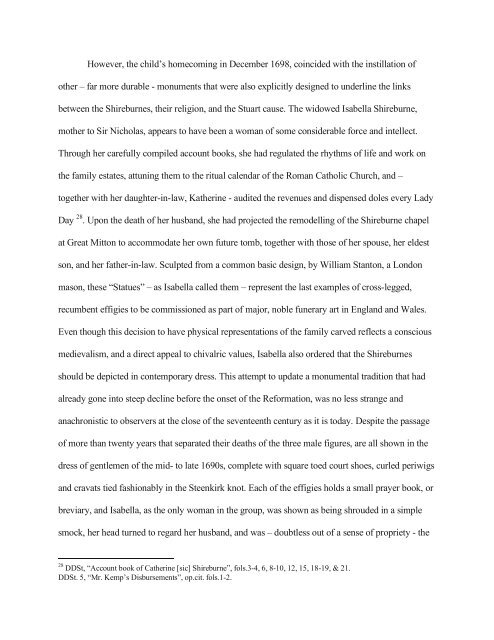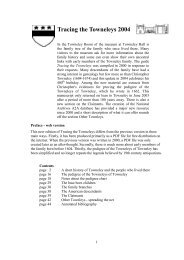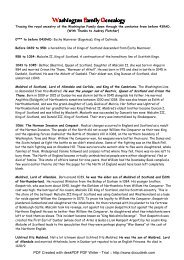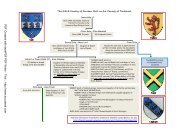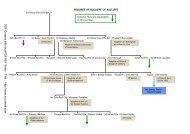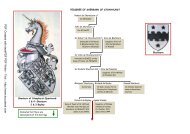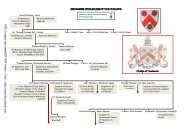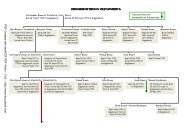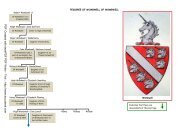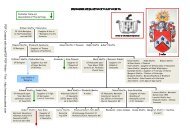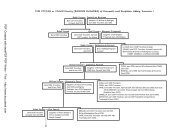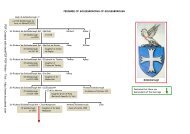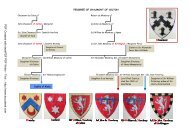SHIRBURNS of Stoneyhurst.pdf - Ingilby History
SHIRBURNS of Stoneyhurst.pdf - Ingilby History
SHIRBURNS of Stoneyhurst.pdf - Ingilby History
Create successful ePaper yourself
Turn your PDF publications into a flip-book with our unique Google optimized e-Paper software.
However, the child’s homecoming in December 1698, coincided with the instillation <strong>of</strong><br />
other – far more durable - monuments that were also explicitly designed to underline the links<br />
between the Shireburnes, their religion, and the Stuart cause. The widowed Isabella Shireburne,<br />
mother to Sir Nicholas, appears to have been a woman <strong>of</strong> some considerable force and intellect.<br />
Through her carefully compiled account books, she had regulated the rhythms <strong>of</strong> life and work on<br />
the family estates, attuning them to the ritual calendar <strong>of</strong> the Roman Catholic Church, and –<br />
together with her daughter-in-law, Katherine - audited the revenues and dispensed doles every Lady<br />
Day 28 . Upon the death <strong>of</strong> her husband, she had projected the remodelling <strong>of</strong> the Shireburne chapel<br />
at Great Mitton to accommodate her own future tomb, together with those <strong>of</strong> her spouse, her eldest<br />
son, and her father-in-law. Sculpted from a common basic design, by William Stanton, a London<br />
mason, these “Statues” – as Isabella called them – represent the last examples <strong>of</strong> cross-legged,<br />
recumbent effigies to be commissioned as part <strong>of</strong> major, noble funerary art in England and Wales.<br />
Even though this decision to have physical representations <strong>of</strong> the family carved reflects a conscious<br />
medievalism, and a direct appeal to chivalric values, Isabella also ordered that the Shireburnes<br />
should be depicted in contemporary dress. This attempt to update a monumental tradition that had<br />
already gone into steep decline before the onset <strong>of</strong> the Reformation, was no less strange and<br />
anachronistic to observers at the close <strong>of</strong> the seventeenth century as it is today. Despite the passage<br />
<strong>of</strong> more than twenty years that separated their deaths <strong>of</strong> the three male figures, are all shown in the<br />
dress <strong>of</strong> gentlemen <strong>of</strong> the mid- to late 1690s, complete with square toed court shoes, curled periwigs<br />
and cravats tied fashionably in the Steenkirk knot. Each <strong>of</strong> the effigies holds a small prayer book, or<br />
breviary, and Isabella, as the only woman in the group, was shown as being shrouded in a simple<br />
smock, her head turned to regard her husband, and was – doubtless out <strong>of</strong> a sense <strong>of</strong> propriety - the<br />
28 DDSt, “Account book <strong>of</strong> Catherine [sic] Shireburne”, fols.3-4, 6, 8-10, 12, 15, 18-19, & 21.<br />
DDSt. 5, “Mr. Kemp’s Disbursements”, op.cit. fols.1-2.


